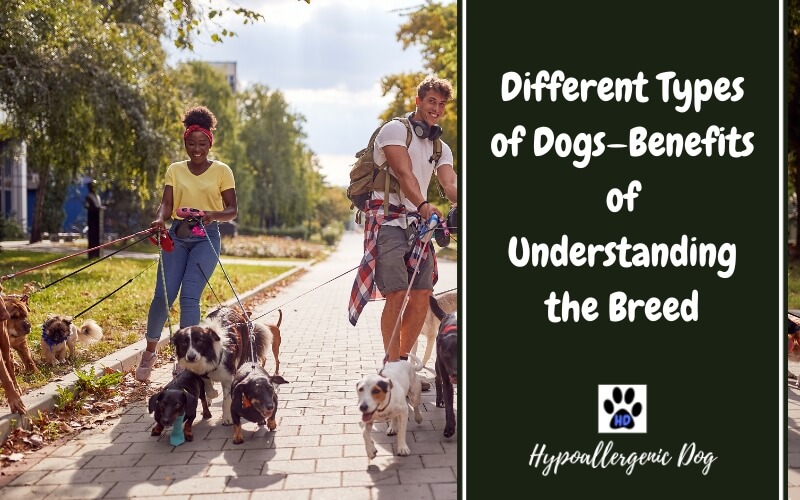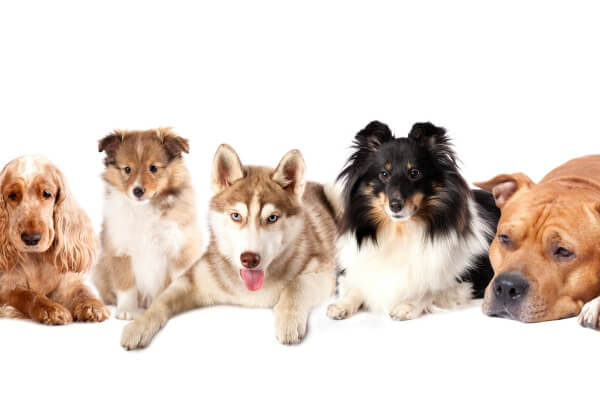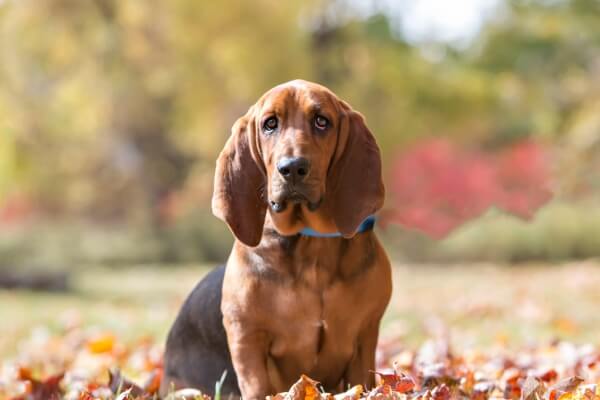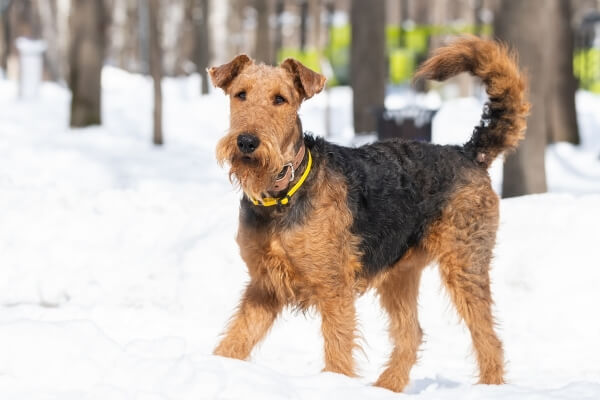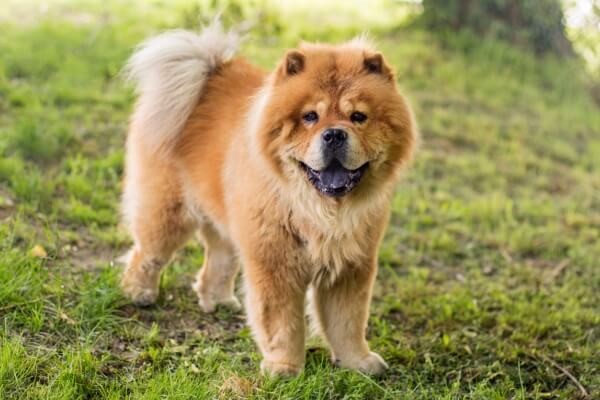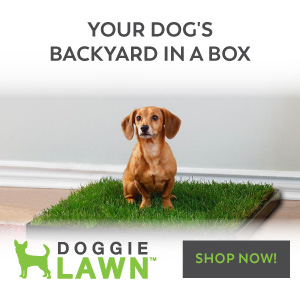Different Types of Dogs — Why Understanding Your Dog’s Breed Class Is Crucial
Jeez, there are many different types of dogs, aren’t there? And nowadays, we don’t only have the purebreds, but also the somewhat unpleasant trend of designer dogs. This overwhelming choice can make picking the right companion a total pain in the butt.
So, just pick the dog you want purely at face value — seems like the best plan. If it appeals to your cuteness level requirements, and is about the size you want, it’s probably the right dog for you.
No, no, no! For goodness sake, no. Don’t do this!
You’re not buying a new car. Going down the looks-only route is going to end in tears — for you, your family, and your canine (figurative tears obviously, dogs can’t express tears when sad, they’re not humans).
Different breeds feature varying temperaments, exercise requirements, cognitive needs, attention demands, and a host of other characteristics — and these need to be compatible with your lifestyle and your intended dog-human relationship.
Therefore, allow me to explain how understanding a dog breed and class not only helps you to choose your canine — but also promotes a healthier and happier life together.
Researching Different Kinds of Dog Breeds
I’m a Lagotto Romagnolo breeder. Want to know what pleases me most when I meet a prospective owner of one of my dogs? It’s when they’ve done their research into the breed.
And, I don’t mean a two-minute Google search and a glance at a Wikipedia page.
I’m talking about serious and hardcore investigation — diving into the dog’s background, characteristics, breed class, and medical problems — from official breeder sites, scientific papers, kennel and owner clubs, and forums. What’s more, the most serious guys have met other owners and attended meets and shows — going to the Nth degree to learn about the animal.
Think about your spouse or partner.
When you choose to marry someone, the plan is to be with them for a lifetime — no matter what happens. Encounter a problem? You work through it. Owning a dog is the same. Understanding the dog early doors means those issues are minimized and can be worked through.
Remember, it’s your dog and your responsibility for possibly the next 14 years. When you adopt, purchase, or rescue it, it’s not a Christmas or birthday present or something to relieve the incessant boredom during a pandemic. It’s not a gift. You don’t give freaking life as a gift. It’s for life.
What’s more, if the dog is for your kids, those kids are going to grow up.
Say you buy a canine for your 10-year-old son. In a few years, puberty is gonna hit, and they’re interested in girls — the dog will take a back seat. No longer are they walking their dog — instead, they’re doing whatever testosterone-fuelled boys do. So, you and your partner are left with full responsibility for the animal — for another 11 years.
Just buy your kids a goldfish instead.
Asking Questions — The Secret Behind Choosing Between Different Dog Breeds
In addition to discovering prospective owners have done their research, what also pleases me is when they ask me questions.
I love to meet people who have been thinking so hard about owning one of my Lagottos that they have pressing concerns or queries. And, I also ask them questions, to ensure they know what they’re getting themselves into — and whether they’re suitable to take one of my beloved dogs.
Unfortunately, many breeders don’t do this.
One of the biggest problems I have with other breeders is that they don’t ask the right questions because they get embarrassed. They don’t want to ask personal details and seem like they’re prying or being nosey.
I just don’t care. That’s my dog, and I’m handing him over into your care. I’m going to be as personal and intrusive as I damn well want to be.
I want to know the answers because your lifestyle will affect how the dog behaves and how happy it is. And, its behavior and happiness will affect your lifestyle — it becomes a perpetual cycle.
However, perhaps most importantly, you need to ask yourself hard-hitting questions to ensure you opt for the most suitable dog class or breed — or indeed, if you should have a dog at all.
Consider:
- What are your living conditions?
- How big is your home?
- Do you have children?
- Do you want a non-shedding dog?
- Why are you only considering certain breeds or classes?
- Are you planning on having the dog inside or outside?
- Do you have other animals?
- How much time can you spend with your dog?
- Do you live an active or lazy life?
- Can you afford a dog?
When you have the answers to these questions, you can then consider the breeds most suited to you and your family and lifestyle.
Importance of Understanding Your Dog Through Its Breed
With the FCI (Fédération Cynologique Internationale) listing over 360 individual breeds — it would be a lengthy process if you attempted to research every individual dog type. It’s much simpler to consider the AKC’s (American Kennel Club’s) seven breed groups — Sporting, Hound, Working, Terrier, Toy, Herding, and Non-Sporting.
While naturally, all different types of dogs and individual breeds within these groups will have their specific nuances and characteristics — generally speaking, they have highly similar requirements, needs, and traits that help you understand your dog.
For example, take the Terrier group.
Including dogs such as Scotties and Westies, Terriers love to enter underground tunnels while on walks — or just stick their faces into holes — and pull out a somewhat surprised mouse, rabbit, or vole.
The dog thinks this is absolutely wonderful. You, however, seeing a petrified and possibly now bloodied small rodent may not be so overjoyed. Your temptation might be to chastise the dog for traumatizing the poor furry animal — but actually, you should be praising and rewarding him for doing the very job he was bred for.
And that’s why understanding the breed is so important.
You don’t have to stick exactly to the often harsh realities of a breed’s background — just grasp what they want to do, and give them alternative opportunities.
In this example, Terriers can be more than entertained with simulated tunnel retrieval through Earthdog trials — in which they hunt a rodent (real, but unharmed) to display and satisfy their burrowing, digging, and pawing behavior.
This catering to instinct, but adapting to your life, is the key behind understanding dog breeds.
Dog Breed Groups — What You Need to Consider
Below are the seven breed groups outlined by the AKC.
I suggest using this guide to gain inspiration for the type of dog most suitable for you — and/or how to understand the needs and behavior of your current companion.
However, bear in mind that the best way to grasp the nuances behind a particular breed is to speak to the breeders, breed and group experts, and specific breed clubs and associations.
Sporting Dog Group
The Sporting Group breeds were originally bred as hunting assistants, mainly for seizing and retrieving birds. Generally speaking, the group is unofficially split into the land hunters such as Spaniels and Pointers — and the water hunters, for example, Retrievers and Lagottos.
Unsurprisingly, these animals love outdoor adventure and are highly energetic. Furthermore, they’re typically excellent to train and fantastic for families who adore alfresco activities. It’s also worth considering that they often show dense, water-resistant coats — required for their swimming and shrub exploring purposes.
Sporting Dog Characteristics To Consider
- Energetic.
- Trainable.
- People-friendly.
- Sturdy and strong.
- Thick protective coats.
- Mouthy.
- Prone to separation anxiety.
- Good with small children.
Sporting Dog Breed Examples
- Labrador Retriever.
- Cocker Spaniel.
- Lagotto Romagnolo.
- Springer Spaniel.
- Vizsla.
Hound Dog Group
Dogs in the hound group are the hunters — bred to catch anything from raccoons to deer. Usually, the group is split into scenthounds — who use their incredible sense of smell to locate and chase prey — and sighthounds, who utilize their rapid turn of pace and wide vision to catch their quarry.
It’s therefore unsurprising these dogs have an immense prey drive — meaning they need to be well-secured in a garden or yard, and on the leash or under strict control when in nature.
Hound Dog Characteristics To Consider
- Single-minded prey drive.
- Require strict training to control.
- Independent — low separation anxiety.
- Not overly vocal or affectionate.
- Moderate exercise needs.
- Enjoy nose-work games.
- Sighthounds are obsessively clean, scenthounds love the dirt.
- High prey drive means they aren’t ideal for homes with babies.
Hound Dog Breed Examples
- Dachshund.
- Greyhound.
- Beagle.
- Bloodhound.
- Basset Hound.
Working Dog Group
If Bruce Springsteen sang songs about dogs, they’d all be about the Working Dog group — the manual laboring, blue-collar canines who toil without complaint to get the job done. But instead of mining, shipbuilding, or steelworking — these dogs guard, rescue, herd, and pull.
Including some of the world’s oldest known breeds, Working Dogs are renowned for power, stamina, and strength. Today, many canines retain their roles as laborers and toilers, satisfying their mental and physical needs — while those in more domestic situations will require significant exercise and stimulation.
Working Dog Characteristics To Consider
- Powerful.
- Highly territorial.
- Need intense training.
- Observant and alert.
- Can be stubborn.
- Many breeds require significant exercise.
- Can adapt well to family life.
- Domestic dogs need activities to simulate their work functions.
Working Dog Breed Examples
- Rottweiler.
- Boxer.
- Doberman Pinscher.
- Great Dane.
- Tibetan Mastiff.
Terrier Dog Group
Active, excitable, and packed full of energy — the Terrier Group represents the diggers, tunnelers, and hole explorers of the canine world. It’s this love of burrowing that allowed them historically to be used for driving out underground animals — such as rabbits, ferrets, and rats.
Despite their original purpose of hunting and killing — they typically make excellent domestic pets. However, bear in mind that they can be stubborn during (necessary) training, require significant exercise and games, and often need specialized stripping to keep their coats in good condition.
Terrier Dog Characteristics To Consider
- Fearless — even against larger threats.
- Playful and mischievous.
- Alert.
- Intelligent.
- Need games and exercise stimulation.
- Loyal.
- Might require coat stripping.
- Many Terrier breeds are prone to separation anxiety.
Terrier Dog Breed Examples
- Scottish Terrier.
- West Highland White Terrier.
- Bull Terrier.
- Airedale Terrier.
- Welsh Terrier.
Toy Dog Group
As their name suggests, the Toys represent the smaller breeds and varieties — generally speaking, the quintessential lap dogs. Some Toy Dog admirers even consider them to be miniature working dogs — but instead of toiling to herd sheep or pull carts,
they work relentlessly to provide attention and love to their owners. To be fair, it’s a bit of a mental stretch.
Nevertheless, these breeds make ideal domestic pets — especially for owners with limited space or without the ability to provide significant outdoor exercise. Relaxed to the point of being lazy (the dogs, and probably the owners too), they can be ideal low-maintenance canines who require little more than cuddles and strokes.
Toy Dog Characteristics
- Small in stature.
- Adaptable to indoor, apartment living.
- Affectionate, often to the point of being obsessive.
- Portable — you can pop them in a carrier and transport.
- Low exercise needs.
- Often have surprisingly long lifespans.
- Typically require significant grooming.
- Generally have bursts of feisty behavior.
Toy Dog Breed Examples
Herding Dog Group
Unsurprisingly, the Herding Group represents the canines that were — and still are in many areas — used to move and control livestock such as sheep, goats, and cattle. Working under the close instruction of a shepherd or handler, they show extensive loyalty and a high adaptability to training.
However, as they’re strong, with significant energy, and an almost obsessive compulsion to herd — if you have one as a pet, they need considerable exercise and stimulation to satisfy their instincts. If you don’t do this, they will try to herd your children or other pets — which, although initially hilarious, may not be ideal in the long term.
Herding Dog Characteristics
- Intelligent.
- Inherent work drive.
- Highly trainable.
- Need exercise and mental stimulation.
- Alert and vigilant.
- Can be overly protective and territorial.
- Excel at problem-solving.
Herding Dog Breed Examples
- Australian Cattle Dog.
- Bearded Collie.
- Belgian Malinois.
- Welsh Corgi.
- German Shepherd.
Non-Sporting Dog Group
The canines in the Non-Sporting Group are characterized by having four legs, a tail, and saying ‘woof.’ Unable to fit comfortably into any of the other six dog groups, the AKC decided to take the easy option and lump them all together — basically into a section that could equally be called ‘other.’
Therefore, trying to make generalizations across the group is challenging — to be honest, it’s a fool’s errand. The Lhasa Apso is as different to the Dalmatian as the Bichon Frise is to the Shar-Pei — and they’re all included in this group. Therefore, if you’re considering a dog from the Non-Sporting Group, research the particular breed.
Non-Sporting Dog Characteristics
- They’re dogs.
- Not Sporting, Working, Hound, Toy, Herding, or Terriers — except the ones that are, like Boston Terriers. Go figure.
Non-Sporting Dog Breed Examples
- American Eskimo.
- Poodle.
- Coton de Tulear.
- Xoloitzcuintli.
- Chow Chow.
- Schipperke.
Understand the Breed, Understand Your Dog
Being a truly responsible canine owner means much more than simply having a basic grasp of the different types of dogs and their names. It demands a thorough understanding of particular breeds — from their history and background through to their temperament and care requirements.
Comprehending your dog’s innate nature, drives, and features means you can provide the perfect home and exercise environment — leading to a wonderful and fulfilling life for the dog, and the ultimate companion, playmate, or working colleague for you and your family.
So, don’t delay! Have a deep dive today into the different types of dogs — and discover how fulfilling this can be for you and your beloved canine.

